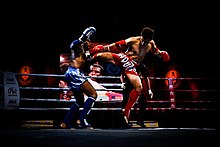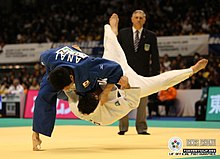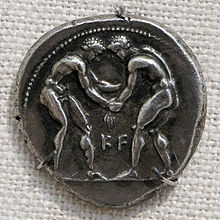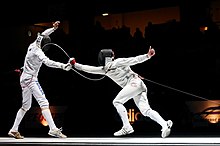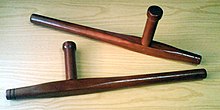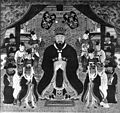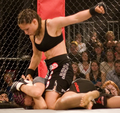Portal:Martial arts
The Martial Arts Portal

Martial arts are codified systems and traditions of combat practiced for a number of reasons such as self-defence; military and law enforcement applications; competition; physical, mental, and spiritual development; entertainment; and the preservation of a nation's intangible cultural heritage. (Full article...)
Although the earliest evidence of martial arts goes back millennia, the true roots are difficult to reconstruct. Inherent patterns of human aggression which inspire practice of mock combat (in particular wrestling) and optimization of serious close combat as cultural universals are doubtlessly inherited from the pre-human stage and were made into an "art" from the earliest emergence of that concept. Indeed, many universals of martial art are fixed by the specifics of human physiology and not dependent on a specific tradition or era.
Specific martial traditions become identifiable in Classical Antiquity, with disciplines such as shuai jiao, Greek wrestling or those described in the Indian epics or the Spring and Autumn Annals of China. (Full article...)
Selected articles
Selected biography
Robinson was a dominant amateur, but his exact amateur record is not known. It is usually listed as 85–0 with 69 knockouts, 40 in the first round. However it has been reported he lost to Billy Graham and Patsy Pesca as a teenager under his given name, Walker Smith Jr. He turned professional in 1940 at the age of 19 and by 1951 had a professional record of 129–1–2 with 85 knockouts. From 1943 to 1951 Robinson went on a 91-fight unbeaten streak, the sixth-longest in professional boxing history behind Pedro Carrasco with 93, Jimmy Wilde with 95, Buck Smith with 102, Packey McFarland with 104, and Young Griffo with 107. Robinson held the world welterweight title from 1946 to 1951, and won the world middleweight title in the latter year. He retired in 1952, only to come back two-and-a-half years later and regain the middleweight title in 1955. (Full article...)
Selected entertainment
The 2011 Money in the Bank was the second annual Money in the Bank professional wrestling pay-per-view (PPV) event produced by WWE. It was held for wrestlers from the promotion's Raw and SmackDown brand divisions. It took place on July 17, 2011, at the Allstate Arena in the Chicago suburb of Rosemont, Illinois. This was the last Money in the Bank held under the first brand extension, which ended in August, but was reinstated in July 2016.
Seven matches were contested at the event, including one broadcast as a dark match. In the main event, CM Punk defeated John Cena to win the WWE Championship and thus, Cena was fired in storyline. In other prominent matches, Christian defeated Randy Orton by disqualification and as per stipulation, he won the World Heavyweight Championship, Alberto Del Rio won the Raw Money in the Bank ladder match for a future WWE Championship match at a time of his choosing, and in the opening contest, Daniel Bryan won the SmackDown Money in the Bank ladder match for a future World Heavyweight Championship at a time of his choosing.
Money in the Bank was broadcast globally and received positive reviews from critics, with the main event receiving the most praise. For pay-per-view buys, 195,000 customers paid to watch the event compared with 165,000 for the previous year.
Sports portals
Selected image
 |
A jump kick is a type of kick in certain martial arts and in martial-arts based gymnastics, with the particularity that the kick is delivered mid-air, specifically moving ("flying") into the target after a running start to gain forward momentum. In this sense, a "Jump kick" is a special case of a flying kick, any kick delivered in mid-air, i.e. with neither foot touching the ground.
Flying and jump kicks are taught in certain Asian martial arts, such as karate, kenpo, kalarippayattu, kung fu and taekwondo. (Full article...)
General images -
Selected quote
Topics
- Regional origin - China - Europe - India - Indonesia - Japan - Korea - Philippines
- Unarmed techniques - Chokehold - Clinch - Footwork - Elbow strike - Headbutt - Hold - Kick - Knee strike - Joint lock - Punch - Sweep - Takedown - Throw
- Weapons - Archery - Duel - Knife fighting - Melee weapons - Shooting - Stick-fighting - Swordsmanship
- Training - Kata - Practice weapon - Punching bag - Pushing hands - Randori - Sparring
- Striking - Boxing - Capoeira - Karate - Kickboxing - Muay Thai - Lethwei - Sanshou - Savate - Taekwondo - Vovinam
- Internal - Aikido - Aikijutsu - Baguazhang - Tai chi - Xing Yi Quan
- Full contact / Combat sports - Professional boxing - Professional kickboxing - Knockdown karate - Mixed martial arts - Pankration - Submission wrestling
- Self-defense / Combatives - Arnis - Bartitsu - Hapkido - Kajukenbo - Krav Maga - MCMAP - Pencak Silat - Systema - Wing Chun - Legal aspects
- Eclectic / Hybrids - American Kenpo - Chun Kuk Do - Jeet Kune Do - Shooto - Shorinji Kempo - Unifight
Categories
Things you can do
See the list on the right of Martial art related projects who organise work on these articles. You can also add your self to the list of Wikipedians by martial art
Talk page tagging
If you come across a martial arts related article, adding the project template {{WikiProject Martial arts}} to the talk page will help identify them for improvement and linking to related articles. For Boxing, Fencing, Mixed martial arts and Sumo. Use {{WikiProject Boxing}}, {{WikiProject Fencing}}, {{WikiProject Mixed martial arts}} and {{WikiProject Sumo}} respectively.
- Assessment
- If possible please assess articles you tag using guidelines (Boxing, Mixed martial arts and Sumo).
Deletions
Monitor and contribute to deletion debates (Boxing).
Find images
Wikipedia requested images of martial artists, mixed martial artists and boxers.
Associated Wikimedia
The following Wikimedia Foundation sister projects provide more on this subject:
-
Commons
Free media repository -
Wikibooks
Free textbooks and manuals -
Wikidata
Free knowledge base -
Wikinews
Free-content news -
Wikiquote
Collection of quotations -
Wikisource
Free-content library -
Wikiversity
Free learning tools -
Wikivoyage
Free travel guide -
Wiktionary
Dictionary and thesaurus
- Pages using the Phonos extension
- Pages with Thai IPA
- Pages including recorded pronunciations
- Pages with Burmese IPA
- Automatically maintained portals with listed maintainers
- Portals with triaged subpages from July 2019
- All portals with triaged subpages
- All portals
- Portals with named maintainer
- Automated article-slideshow portals with less than 2 articles in article list
- Random portal component with 16–20 available subpages
- Random portal component with 16–20 available image subpages
- Martial arts portal
- Martial arts
- Portals needing placement of incoming links
![Image 1 A fighter leans back to evade a round kick Muay Thai (Thai: มวยไทย, RTGS: muai thai, pronounced [mūa̯j tʰāj] ⓘ), sometimes referred to as Thai boxing, is a Thai martial art and full-contact combat sport that uses stand-up striking, sweeps, and various clinching techniques. This discipline is known as the "Art of eight limbs", as it is characterised by the combined use of fists, elbows, knees and shins. Muay Thai became widespread internationally in the late 20th to 21st century, when Westernised practitioners from Thailand began competing in kickboxing and mixed-rules matches as well as matches under Muay Thai rules around the world. The professional league is governed by The Professional Boxing Association of Thailand (P.A.T.), sanctioned by The Sports Authority of Thailand (S.A.T.). Muay Thai is related to other martial art styles such as Muay Chaiya, Muay Boran, Muay Lao, Kun Khmer, Lethwei, Benjang and Tomoi. A practitioner of Muay Thai is known as a Nak Muay. Western practitioners in Thailand are sometimes called Nak Muay Farang, meaning "foreign boxer". (Full article...)](http://upload.wikimedia.org/wikipedia/en/d/d2/Blank.png)
